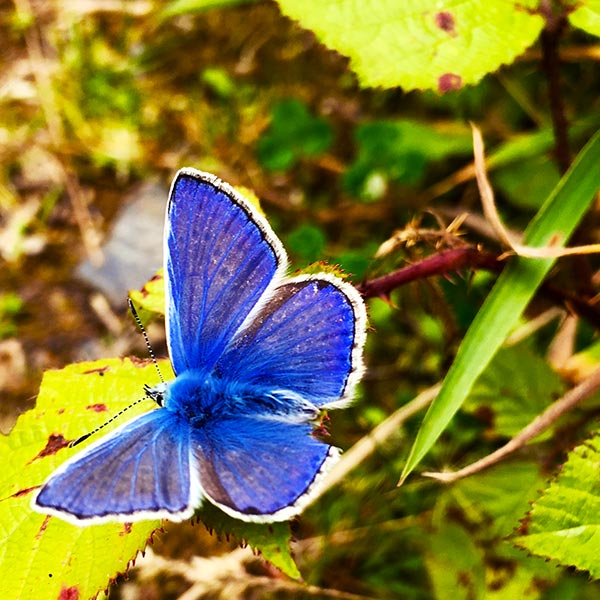
Plants to Encourage Wildlife in the Garden
Wild gardening; planning what variety of plants to include with some thought can make your garden attractive to wildlife and actually increase the biodiversity in your locality.
Butterflies
To attract a good butterfly population to the garden one needs caterpillar host plants species, nectar-rich plants to feed the adults and suitable shelter plants for overwintering species of butterfly. Caterpillar host plants include nettles, willow, holly, ivy, wild strawberries, vetches, trefoils and potentillas and long grass, so leave a patch unmown. Nectar plants should be selected to ensure availability over the seasons and include: Hawthorn, Mints, Lavenders, Hebes, Pinks (dianthus), Aubretia, Thymes, Asclepias, Buddleia, Calamints, Eupatoriums, Echinaceas, Globe artichoke, Helichrysums, Liatris, Bergamots, Oreganos, Scabious, Goldenrod, Elder, Verbenas and Vervain, Sedums, ivy (encourage it to flower by making sure some tendrils hang loose). Ivy is also a valuable winter shelter.

Hoverflies
Sweet alyssum, dill, coriander, poached egg plant, pot marigold, wild carrot, Melissa, mints, parsley, ajuga, alliums, feverfew. They tend to prefer white and yellow flowered plants.
Lacewings
Yarrow, dill, angelica, dyers chamomile, coriander, cosmos, wild carrot, fennel
Bees
Borage, thyme, sage, lavender and other aromatic herbs are great for bees and good for their immune systems. Spring flowers such as primrose, lungwort. Fruit blossoms are good for bumblebees and other bees species
Birds
Small birds such as finches love feeding on the seeds of fennel, evening primrose and other seed-bearing plants in the autumn. Fruiting hedges containing female holly, hawthorn, crab apples, wild rose, sloes, sea buckthorn, blackberries, elderberries, and other fruit are also great food (though there may be some competition for the fruit from humans). Also, pyracanthas, berberis, and cotoneaster. Plants that attract insects that birds feed on are also beneficial. Hedges and trees for nesting sites are obviously a really important feature too.
Moths
Night time moths; honeysuckle, jasmine, evening primrose, clary sage. Daytime moths such as hummingbird hawk moths; pinks, sweet william and carnations, sage, clary sage and other aromatic flowers. Cinnabar moth caterpillars feed on ragweed, although most of us do not want to encourage this in our gardens.
Hedgehogs
Include grassroots and berries in their diet. They also eat mushrooms so gardening practices that encourage the growth of mushrooms are good; and earthworms which are encouraged by not over digging and by good composting and application of compost.

Earthworms
Do not eat plants but can be encouraged by reducing deep digging and making good composts.
It is good to try and plan plantings so that there are nectar and pollen producing plants over a wide a season as possible eg primrose and lungwort and rosemary for early spring, a wide variety for the summer and Sedum and ivy for the autumn.
Successional sowings (sowing seeds over several months) can extend the flowering season, as can deadheading (removing flowers from plants such as calendula before they go to seed) so that the pant continues to generate new flowers.
Nuts and acorns are good food for jays, crows, pigeons and red squirrels. Ivy is useful autumn food for butterflies and bees as is Sedum spectabile. Ground cover, green manures and mulches are good for encouraging beetles but may harbour slugs as well.
I guess slugs are wildlife too but can be rather indiscriminate about which plants they devour.
Suggested plants (both native and ornamental) to include:
Annual plants baby’s breath, cornflower, basils, phacelia, birdsfoot trefoil, cosmos, borage, calendula/pot marigold, Californian poppy, candytuft, coriander, maize (there are colourful ornamental varieties), corn poppy, poached egg plant, sunflower.
Biennial Plants
Wild celery, parsley, chervil, mullein, angelica, alkanet, evening primrose, teasel.
Perennial Plants
Anise hyssop, mints, eupatorium species, especially hemp agrimony, ajuga catmints, comfrey, lungwort, thymes, rosemary, sages, crocuses, daffodils and narcissi, fennel, lovage, feverfew, tansy, goldenrod, Jerusalem artichoke, elecampane, globe artichoke, chives, lavenders, paeonies, mallows, Queen Anne's lace/wild carrot, sea pinks, stonecrops, yarrow, meadowsweet, wild strawberry, buddleia, roses (the more fragrant the better for insects and wild roses for the best fruit for birds), elders, hawthorn, lime blossom, apples, pears and other fruiting trees, willow, holly, oak, Sycamore
Some good books include:
RSPB Gardening for Wildlife: A Complete Guide to Nature-friendly Gardening by Adrian Thomas
The Wildlife Gardener: Creating a Haven for Birds, Bees and Butterflies by Kate Bradbury
Alan Titchmarsh How to Garden: Wildlife Gardening by Alan Titchmarsh
Gardeners' World: 101 Ideas for a Wildlife-friendly Garden by Mick Lavelle
Wildlife Gardening for Everyone: Your Questions Answered by the RHS and the Wildlife Trust by Malcolm Tait and Lou Millward
How to Make a Wildlife Garden by Chris Baines
Seeds and plants
It is always good to sow seed from local sources.
Native wildflower seed mixes are available from
www.seedaholic.com
www.brownenvelopeseeds.com
www.irishseedsavers.ie
www.theorganiccentre.ie
www.theherbgarden.ie
www.futureforests.net
www.ionaherbal.ie
www.peppermintfarm.com
